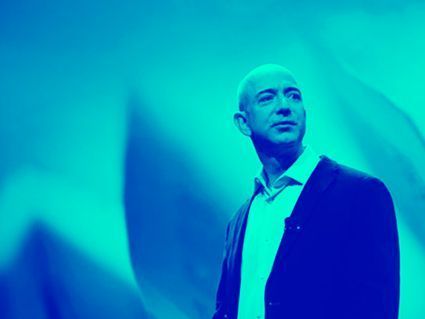The Jeff Bezos School of Long-Term Thinking

If you want to know about Amazon CEO Jeff Bezos’ obsession with longevity, all you have to do is read up about his side projects. You could check out his super-secretive aerospace company, Blue Origin. Or you could look in the Sierra Diablo Mountain Range in Texas, where Bezos is carving out a hole in one of the mountainsides to build a 10,000-year clock using $42 million of his own money.
Why focus 10,000 years into the future? The answer lies in Bezos’ letter to Amazon shareholders from 1997 when the company went public, a manifesto of sorts about the benefits and approaches to long term thinking.
The 1997 letter’s main point: we can’t realize our potential as people or as companies unless we plan for the long term. Every subsequent year Bezos has ended shareholder letters by attaching the original 1997 essay with a reminder of the importance of thinking long term. And every year, he is proven right.
The company that started out as a few guys in a garage has now revolutionized the way we buy everything from books to toys to clothes. Amazon is now one of the 100-largest companies in America, mostly thanks to bold long term plays like the Amazon Kindle.
“If everything you do needs to work on a three-year time horizon, then you’re competing against a lot of people,” Bezos told Wired in 2011. “But if you’re willing to invest on a seven-year time horizon, you’re now competing against a fraction of those people, because very few companies are willing to do that.”
In a nod to Bezos’ obsession with long-term thinking, 99U has combed through a dozen interviews and profiles on the CEO and pulled out a handful of his day-to-day habits that can help you keep an eye on the long term, just like Bezos.
1. Write out new ideas.
At Amazon, senior executive meetings don’t start out with conference calls or PowerPoint presentations, they start out with reading. Lot’s of it. From a Fortune profile:
Bezos says the act of communal reading guarantees the group’s undivided attention. Writing a memo is an even more important skill to master. “Full sentences are harder to write,” he says. “They have verbs. The paragraphs have topic sentences. There is no way to write a six-page, narratively structured memo and not have clear thinking.”
As Ben Casnocha points out, when you’re speaking it’s easy for audiences to fill in the gaps in your ideas and for you to gloss over the details. By demanding his team to write everything out, it makes them consider all aspects of an idea to make it more durable for years to come.
2. Incentivize team members for the long term: make them owners.
Compared to the lavish salaries and perks of some other established Silicon Valley tech companies, Amazon likes to run lean. The company doesn’t give its employees free snacks, keeps salaries low, and even once (allegedly) preferred to use doors as desks instead of expensive modern furniture. But that doesn’t mean employees aren’t well compensated.
Amazon prefers to reward employees with stock options rather than cash. Bezos explains his logic in the 1997 letter: “We know our success will be largely affected by our ability to attract and retain a motivated employee base, each of whom must think like, and therefore must actually be, an owner.”
3. Follow the “two pizza rule.”
Bezos believes in avoiding complacency at all costs, especially when reinforced by groupthink. From a Wall Street Journal profile:
One former executive recalled that, at an offsite retreat where some managers suggested that employees should start communicating more with each other, Mr. Bezos stood up and declared, “No, communication is terrible!” He wanted a decentralized, even disorganized company where independent ideas would prevail over groupthink.
His antidote? Make his teams as small as possible while throttling communication where appropriate. Bezos said he believed in “two pizza teams”: if a team couldn’t be fed with two pizzas, it was too big.
4. Dedicate time to think about the future.
A 1999 Wired profile of Bezos revealed that he purposefully keeps two unstructured days a week on his calendar so he could allow his mind to wander and generate new ideas. Sometimes he just surfed the web, other times he set up his own meetings.
5. Routinely “check in” on long-term goals.
The same Wired profile reported that Bezos meets with his assistant every quarter to assess his progress on 12 pre-selected initiatives. Mainly, he wants to assure himself that he is spending adequate time on each one by reviewing the past three months of his calendar. The exercise enables him to “check in” to make sure he stays true to his long-term goals and while not getting distracted by new and fleeting ideas.
6. Work backwards.
As Amazon jumps from books to music to web hosting to content creation, its endeavors may seem random, but are all the result of working backwards from a common goal of customer satisfaction. This is opposed to a “skills-forward” approach where people – and companies – let what they are good at determine next steps.
From Bezos’ 2008 shareholder letter:
Eventually the existing skills will become outmoded. Working backwards … demands that we acquire new competencies and exercise new muscles, never mind how uncomfortable and awkward-feeling those first steps might be.
Bezos even applies this logic to his personal life. When he has to make big decisions he often works backwards and thinks about how he’ll feel about the choice when he is 80. As he was weighing whether to quit his day job to start Amazon, he told Wired that potential regret made him say yes.
“Am I going to regret leaving Wall Street? No. Will I regret missing the beginning of the Internet? Yes.”